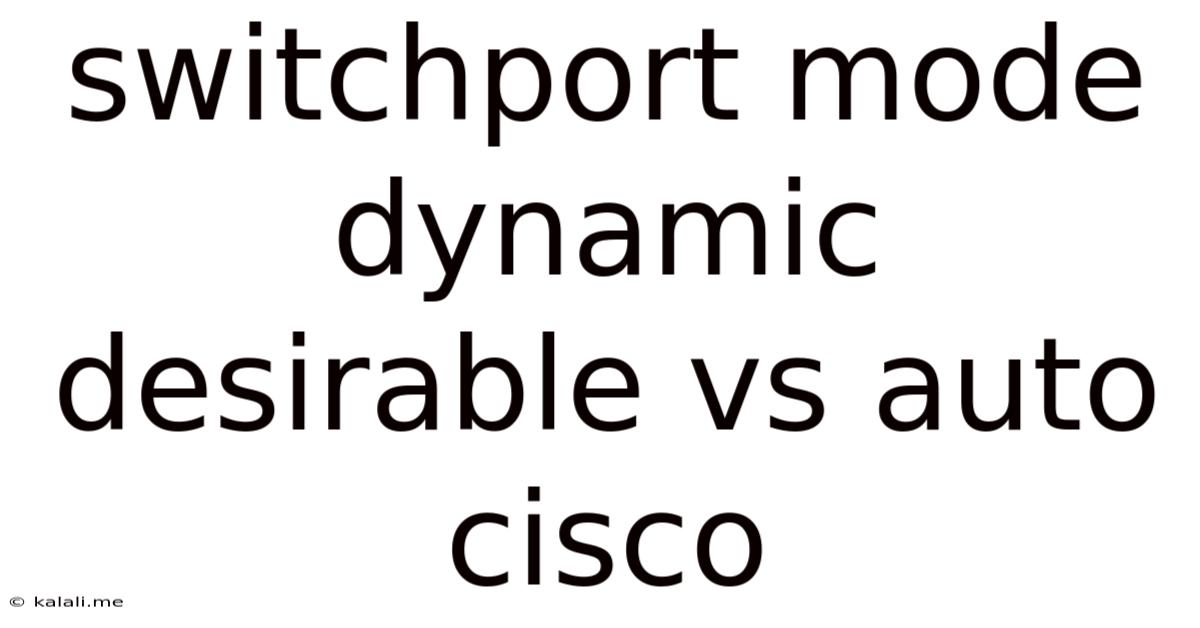Switchport Mode Dynamic Desirable Vs Auto Cisco
Kalali
May 27, 2025 · 4 min read

Table of Contents
Switchport Mode: Dynamic Desirable vs. Auto on Cisco Switches
This article dives deep into the differences between dynamic desirable and auto switchport modes on Cisco switches, helping you understand which is best for your network configuration. Choosing the right mode is crucial for establishing reliable and secure trunk links between switches, and preventing common connectivity issues. We'll cover the functionality, implications, and best use cases for each, arming you with the knowledge to make informed decisions. This comprehensive guide will ensure you can effectively manage your Cisco network's switchport configurations.
Understanding Switchport Modes: The Basics
Before delving into the specifics of dynamic desirable and auto, let's establish a foundational understanding of switchport modes. These modes determine how a port negotiates its role in a trunk link – a connection capable of carrying multiple VLANs. The primary modes are:
- Access: The port carries traffic for only one VLAN. This is the standard mode for connecting end devices like computers and printers.
- Trunk: The port carries traffic for multiple VLANs, enabling communication between different network segments.
- Dynamic Desirable: The port attempts to negotiate a trunk link but prioritizes being a trunk.
- Dynamic Auto: The port attempts to negotiate a trunk link but is less assertive.
Dynamic Desirable: The Assertive Negotiator
The dynamic desirable mode aggressively tries to establish a trunk link. If connected to another port configured as dynamic desirable, dynamic auto, or trunk, it will form a trunk. If connected to an access port, it will remain an access port. This assertive behavior can be advantageous in situations where you want to ensure a trunk connection is established.
Key Characteristics of Dynamic Desirable:
- Aggressive Negotiation: Actively seeks to create a trunk link.
- Priority as Trunk: Prioritizes trunk functionality over access.
- Suitable for Core/Distribution Layers: Ideal for connections between switches where trunk links are essential.
- Potential for Conflicts: Can lead to conflicts if two
dynamic desirableports connect.
Dynamic Auto: The Passive Approach
dynamic auto takes a more passive approach to trunk negotiation. It will form a trunk link only if connected to a port configured as dynamic desirable or trunk. If connected to an access port, it remains an access port. This mode is suitable for situations where you want to avoid potential conflicts, allowing other ports to dictate the connection type.
Key Characteristics of Dynamic Auto:
- Passive Negotiation: Awaits an offer from the connecting device to establish a trunk.
- No Trunk Priority: Does not prioritize trunk functionality over access.
- Suitable for Edge Layers: Ideal for connections to access switches or end devices.
- Avoids Conflicts: Less likely to cause conflicts than
dynamic desirable.
Dynamic Desirable vs. Dynamic Auto: A Comparison Table
| Feature | Dynamic Desirable | Dynamic Auto |
|---|---|---|
| Negotiation | Aggressive | Passive |
| Trunk Priority | Yes | No |
| Conflict Risk | Higher | Lower |
| Ideal Location | Core/Distribution | Edge |
| Default behavior with another Dynamic Auto | forms trunk | forms access |
Choosing the Right Mode for Your Network
The best choice depends on your network topology and requirements:
- Use Dynamic Desirable on core and distribution switches to ensure that inter-switch links are trunks. This will help to maintain a consistent and reliable network backbone. Plan carefully to avoid unintentional looping scenarios resulting from connecting two "dynamic desirable" ports.
- Use Dynamic Auto on edge ports that connect to end devices or access switches. This prevents accidental trunk formation and ensures that end-user devices are connected to the appropriate VLAN.
Troubleshooting and Best Practices
- Verify switchport configurations: Always double-check your switchport configurations to prevent mismatches and connectivity issues.
- Use cable testing tools: Ensure your cabling is correctly connected and working.
- Check switch logs: Review switch logs for error messages related to trunk negotiation.
- Implement a structured cabling system: A well-documented and organized cabling system simplifies troubleshooting.
By understanding the nuances of dynamic desirable and auto switchport modes, you can effectively manage your Cisco network, optimize connectivity, and prevent common configuration errors. Remember, selecting the appropriate mode significantly impacts network performance and stability. Carefully consider your network's architecture and design before implementing these configurations.
Latest Posts
Latest Posts
-
Keebler Club And Cheddar Crackers Expiration Date
Jul 10, 2025
-
In Many States Trailers With A Gvwr Of 1500
Jul 10, 2025
-
How Many Tablespoons Are In A Hidden Valley Ranch Packet
Jul 10, 2025
-
Which Is The Best Summary Of The Passage
Jul 10, 2025
-
How Many Quarts Of Soil In A Cubic Foot
Jul 10, 2025
Related Post
Thank you for visiting our website which covers about Switchport Mode Dynamic Desirable Vs Auto Cisco . We hope the information provided has been useful to you. Feel free to contact us if you have any questions or need further assistance. See you next time and don't miss to bookmark.